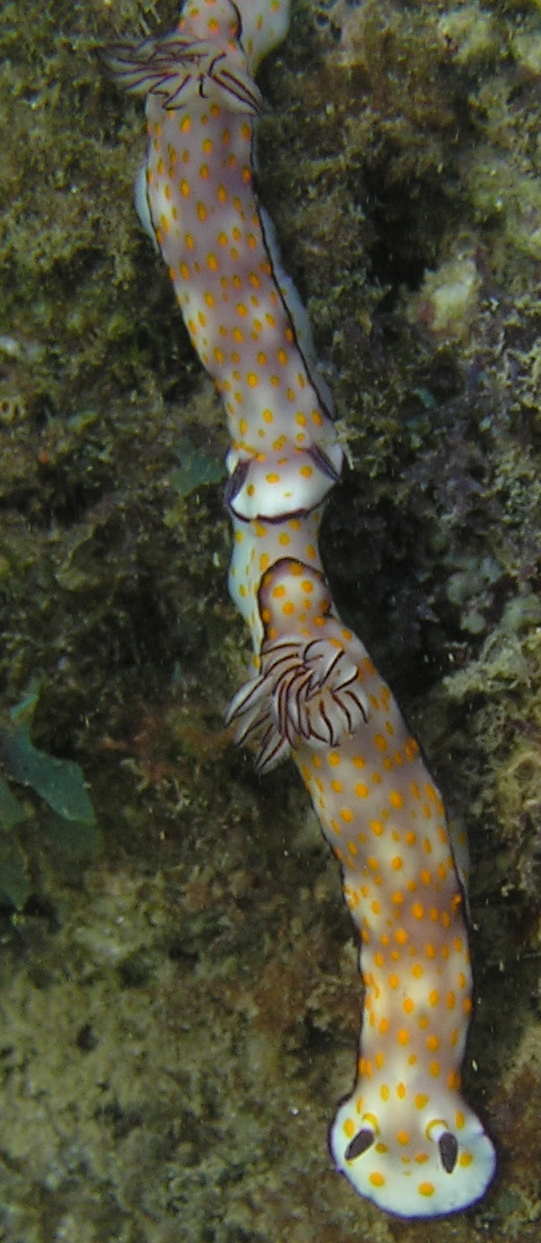zurück Übersicht
Pyjamaschnecke sehr farbenprächtige
Meeresschneckenart doride Nacktschnecke Seehase
zurück
vor

The
Pyjamaschnecke, known in English as the
Sea Hare or
Aplysia, is a type of
marine gastropod mollusk. This
creature gets its common name from the
distinctive coloration and appearance, which is said to resemble the
"pyjamas" due to its contrasting colors, often having dark patches on a lighter
background.
Key Features of the
Pyjamaschnecke (Sea Hare):
1.
Appearance
-
Coloration: Sea Hares can vary in color, but many species have a
soft, somewhat gelatinous body, often with a mottled or patchy color
pattern. The typical "pyjama" pattern can be seen with
dark, patchy markings
against a lighter background.
-
Body Structure: Sea Hares
have an elongated, soft body
with a pair of tentacle-like
structures called
rhinophores, which help them detect chemicals in the water. They
also have two flaps (called
parapodia) on either side
of their body that resemble a pair of ears, contributing to their "hare"
appearance.
-
Size: Depending on the
species, Sea Hares can range in size from just a few centimeters to over a
meter long.
2.
Habitat
-
Marine Environment: Sea
Hares are typically found in
shallow coastal waters, especially in regions with
seaweed or
kelp beds, where they can
graze on algae. They prefer warm, temperate, and tropical seas.
-
Distribution: Sea Hares
are found in various parts of the world, particularly in the
Indo-Pacific,
Atlantic, and
Mediterranean regions.
3.
Diet
-
Herbivores: Sea Hares are
primarily herbivorous,
feeding on various types of algae, including
seaweed and
kelp. Their feeding
behavior plays an essential role in the ecosystem by helping control algae
populations.
-
Grazing: They use their
radula, a toothed,
tongue-like structure, to scrape algae off rocks or other surfaces in their
environment.
4.
Behavior
-
Slow Movements: Sea Hares
are generally slow-moving animals, using their large parapodia to undulate
in the water, which allows them to move at a relaxed pace.
-
Reproduction: Sea Hares
have both male and female
reproductive organs, making them
hermaphroditic. They
engage in a process where multiple individuals may lay
egg masses on substrates
like rocks. These egg masses can be quite colorful and are often bright in
shades like pink,
orange, or
yellow.
5.
Defense Mechanism
-
Ink Secretion: One of the
most notable defense mechanisms of the Sea Hare is the ability to release a
cloud of purple ink when
threatened. The ink is secreted from glands near their anus and can
disorient predators, allowing the Sea Hare to escape. This ink contains
chemicals that may also
act as a deterrent to predators.
-
Toxicity: Some species of
Sea Hares may also produce chemicals in their bodies that are unpalatable or
mildly toxic to predators.
6.
Ecological Importance
-
Algae Control: As
herbivores, Sea Hares play a role in controlling the growth of algae and
maintaining the balance of the ecosystem. By feeding on algae, they help
prevent algal overgrowth that could otherwise harm the marine environment.
-
Food Source for Predators:
Despite their defensive mechanisms, Sea Hares are a food source for various
marine predators, including crabs,
fish, and some
sea birds.
7.
Interesting Facts
-
Ink Color: The ink
produced by Sea Hares is not only for defense but is also a distinctive
feature. The ink is purple or blue in color and can be quite dramatic when
it is released into the water.
-
Regenerative Abilities:
Some species of Sea Hares have the ability to
regenerate parts of their
bodies if they are damaged, such as their
tentacles or parts of
their parapodia.
-
Inspiration for Research:
Sea Hares have been subjects of scientific research due to their
nervous system, which is
relatively simple and well understood. They are often used in studies
related to neurobiology
and learning.
Conclusion:
The Pyjamaschnecke (Sea Hare)
is a fascinating and unique marine creature, recognized for its soft, colorful
body and distinctive "pyjama" appearance. Its slow-moving, herbivorous
lifestyle, combined with its remarkable ink defense mechanism, makes it an
interesting species to study and observe. Whether you're a marine enthusiast, a
diver, or simply curious about ocean life, encountering a Sea Hare is an
unforgettable experience.
 26.07.25 Copyright Dirk
Rauschenbach Koelnerstrasse 293 51702 Bergneustadt
Datenschutzerklaerung 02261 9788972 Mail ccooly(
at) web.de
26.07.25 Copyright Dirk
Rauschenbach Koelnerstrasse 293 51702 Bergneustadt
Datenschutzerklaerung 02261 9788972 Mail ccooly(
at) web.de
 Safaris
Bergsteigen
Wandern
Inselwandern Weltweit
Safaris
Bergsteigen
Wandern
Inselwandern Weltweit
 Europa
Inselwandern
Europa
Inselwandern
 Städtewandern
Städtewandern
 Paintings
Paintings Dirk Rauschenbach
Dirk Rauschenbach
 Safaris
Bergsteigen
Wandern
Inselwandern Weltweit
Safaris
Bergsteigen
Wandern
Inselwandern Weltweit
 Europa
Inselwandern
Europa
Inselwandern
 Städtewandern
Städtewandern
 Paintings
Paintings Dirk Rauschenbach
Dirk Rauschenbach
![]() 26.07.25 Copyright Dirk
Rauschenbach Koelnerstrasse 293 51702 Bergneustadt
Datenschutzerklaerung 02261 9788972 Mail ccooly(
at) web.de
26.07.25 Copyright Dirk
Rauschenbach Koelnerstrasse 293 51702 Bergneustadt
Datenschutzerklaerung 02261 9788972 Mail ccooly(
at) web.de